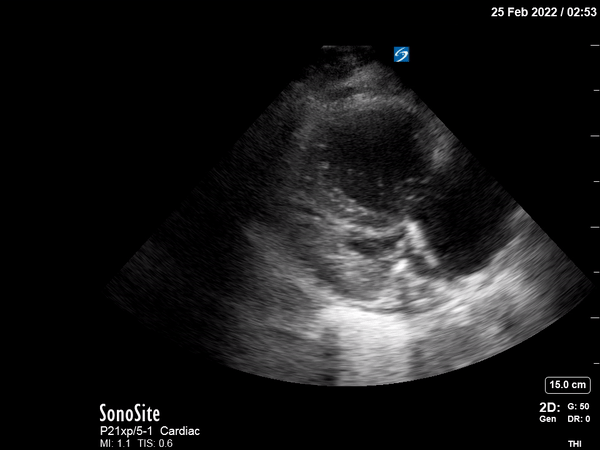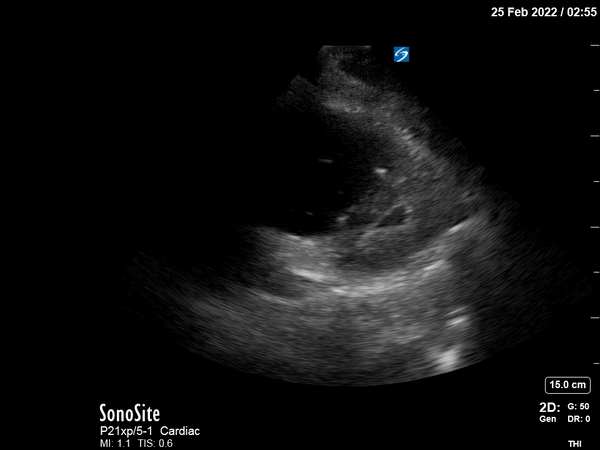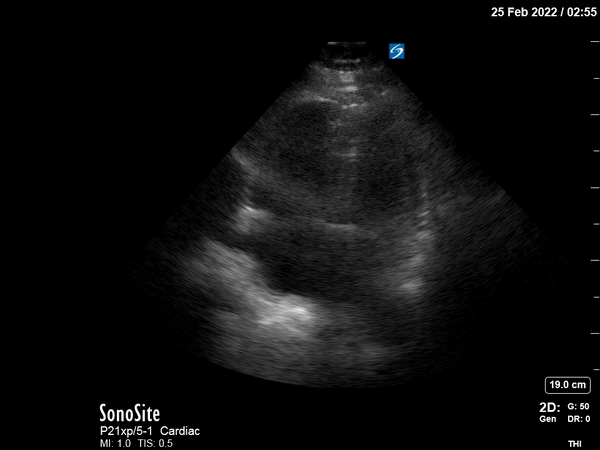Under Pressure
Rajendraprasad, Sanu S1
Gary, Phillip J1
Wiley, Brandon M2
Park, John G1
1Division of Pulmonary and Critical Care Medicine, Mayo Clinic, Rochester, MN.
2Department of Cardiovascular Medicine, Mayo Clinic, Rochester, MN.
Case
A 75-year-old female with a history of multiple myeloma in remission, IgG deficiency, OSA, paroxysmal atrial fibrillation not on anticoagulation was admitted for COVID-19 pneumonia. She was admitted to a monitored unit, placed on a high-flow nasal cannula, and received remdesivir and dexamethasone, and antibiotics for urinary tract infection. Several hours after admission, she decompensated and was transferred to the medical intensive care unit where she underwent endotracheal intubation for tachypnea and worsening hypoxia. Following intubation, she manifested shock requiring multiple vasoactive medications. Laboratory findings were notable for lactate > 12 and PaO2:FiO2 ratio of 80. ECG revealed findings of S1Q3T3 and T wave inversion in lead V1 & V2.
Bedside point-of-care ultrasound (POCUS) assessment of the heart showed:
Video 1. Parasternal long axis
Video 2. Parasternal short axis
Severe RV dilation, flattening of the interventricular septum during systole and diastole, and compromised LV filling.
Video 3. Apical 4 chamber
Dilated RV with McConnell sign - paradoxical RV apical “hyperkinesis” in the setting of RV global hypokinesis
Question
With the above ECG and POCUS findings, what would be your immediate next step?
- Thrombolytic therapy
- Interventional Radiology (IR) guided thrombectomy
- Restart broad-spectrum antibiotics
- Emergent cardiac catheterization
A. Thrombolytic therapy
Discussion
This patient's acute decompensation is concerning for acute right ventricular failure secondary to massive pulmonary embolism (PE). The ECG findings of S1Q3T3 and T wave inversion in lead V1 & V2 are suggestive of right ventricular strain, with the incidence of PE varying from 11-50%.1 POCUS confirmed the diagnosis of cardiogenic shock due to acute RV failure and provided invaluable anatomic and physiologic information to guide further management in the resuscitation of the patient.
POCUS shows multiple findings consistent with acute right ventricular (RV) systolic failure in the setting of increased RV afterload. Parasternal long and short axis views show severe RV dilation, flattening of the interventricular septum during systole and diastole, and compromised LV filling. The parasternal long axis also demonstrates dynamic obstruction of the LV outflow tract caused by systolic anterior motion of the mitral valve (SAM), inadequate LV preload, displacement of the interventricular septum, and tachycardia. The apical four-chamber view shows a dilated RV with a McConnell sign (paradoxical RV apical “hyperkinesis” in the setting of RV global hypokinesis).2
The spectrum of the pathophysiology of acute RV failure is complex with multiple contributors. The physiology of the RV is optimized for the highly compliant pulmonary vasculature. Acute elevation of pulmonary vascular resistance (PVR) can occur due to pulmonary embolism, hypoxia, and acidosis. A significant and rapid increase in PVR can cause decoupling of the RV and pulmonary artery leading to RV failure. In the setting of high afterload, the RV dilates to maintain stroke volume. This dilation of the RV can cause pericardial constraint, enhancing interventricular dependence and placing the LV at a mechanical disadvantage with decreased diastolic filling. The underfilled LV attempts to increase cardiac output through hyperkinesis and tachycardia which creates the milieu for dynamic LVOT obstruction. The dynamic LVOT obstruction further reduces cardiac output driving a physiologic spiral that further impairs RV function resulting in increased RV dilation and ischemia. Management consists of optimizing RV preload and afterload in order to improve RV/LV mechanics. Ventilatory support to improve gas exchange, thrombolysis, vasopressors, inotropes, renal replacement therapy, pulmonary vasodilators, and in extreme cases mechanical support should be considered.3, 4 Thus, in the question above, answer choice A is correct. Due to her hemodynamic instability and tenuous clinical condition, IR guided thrombectomy would not be advised (answer choice B is incorrect). Since this is not due to acute infection, broad-spectrum antibiotics would not be helpful acutely (answer choice C is incorrect). The constellation of findings is not due to acute obstruction of a coronary vessel for which emergent cardiac catheterization would be helpful (answer choice D is incorrect).
In this hemodynamically unstable patient with evidence of acute RV failure and no contraindications, we elected to give systemic thrombolytic therapy amid resuscitation. Given LV outflow obstruction with severely underfilled LV and multiple vasopressors including phenylephrine, management options were limited. In such a situation, the next optimal approach would be to initiate pulmonary vasodilator therapy and venoarterial ECMO, normalize cardiac output, stabilize biventricular function, and optimize oxygenation.3-5
The patient’s family did not wish to escalate care and she was transitioned to comfort care consistent with her previously expressed wishes.
References
-
Chan TC, Vilke GM, Pollack M, Brady WJ. Electrocardiographic manifestations: pulmonary embolism. J Emerg Med. 2001;21(3):263-270. doi:10.1016/s0736-4679(01)00389-4
-
Walsh BM, Moore CL. McConnell's Sign Is Not Specific for Pulmonary Embolism: Case Report and Review of the Literature. J Emerg Med. 2015;49(3):301-304. doi:10.1016/j.jemermed.2014.12.089
-
Konstam MA, Kiernan MS, Bernstein D, et al. Evaluation and Management of Right-Sided Heart Failure: A Scientific Statement From the American Heart Association. Circulation. 2018;137(20):e578-e622. doi:10.1161/CIR.0000000000000560
-
Ventetuolo CE, Klinger JR. Management of acute right ventricular failure in the intensive care unit. Ann Am Thorac Soc. 2014;11(5):811-822. doi:10.1513/AnnalsATS.201312-446FR
-
Grant C Jr, Richards JB, Frakes M, Cohen J, Wilcox SR. ECMO and Right Ventricular Failure: Review of the Literature. J Intensive Care Med. 2021;36(3):352-360. doi:10.1177/0885066619900503






